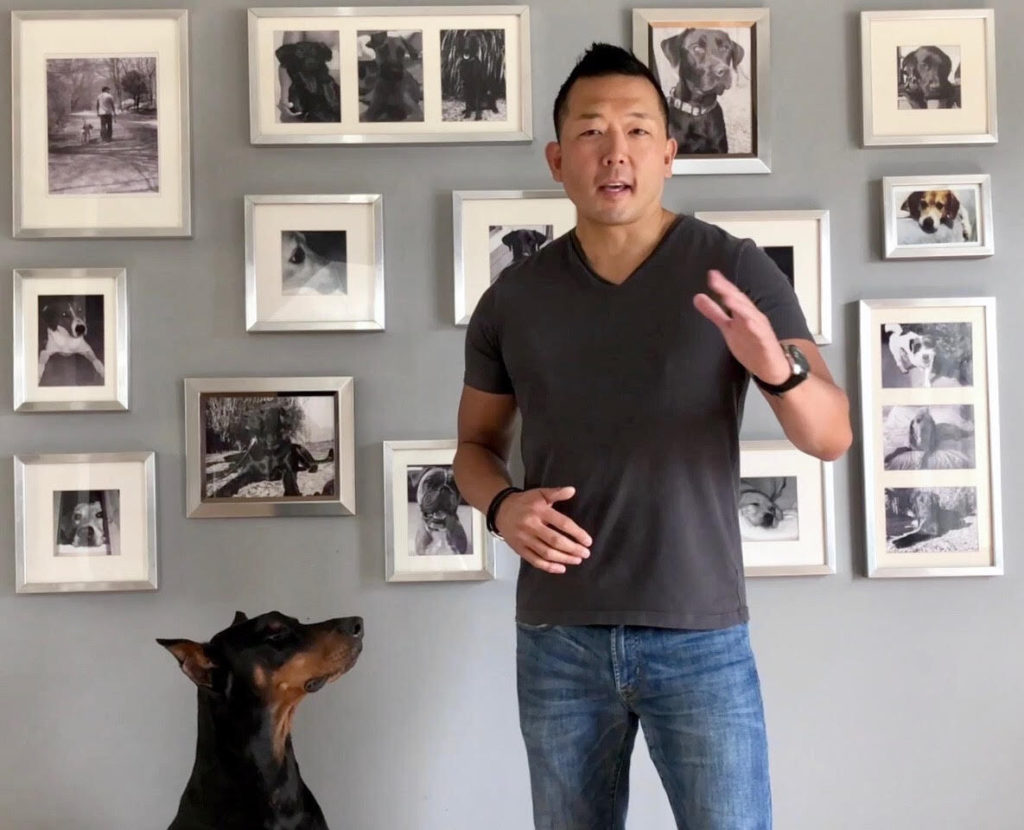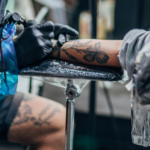
In this episode we talk to Michael Shikashio about how he built a thriving dog training business focused on difficult aggression cases. He is the founder of AggressiveDog.com and focuses on
teaching other professionals from around the world on how to successfully work with
aggression cases – You may know him as the host of the popular podcast “The Bitey End of the Dog” or from being covered in major media like the New York Times, New York Post, Fox News, Baltimore Sun, Women’s Health Magazine, Real Simple Magazine, SiriusXM Radio.
Below you can connect to this conversation through your podcast service of choice or on YouTube. Keep reading for links to Michael Shikashio’s website and training business and a full written transcript of our conversation.
Listen on


PocketSuite Links
YouTube
https://www.youtube.com/@PocketSuite/featured
TikTok
https://www.tiktok.com/@pocketsuite
https://www.instagram.com/PocketSuite
Michael Shikashio Links
Website
School
https://aggressivedog.thinkific.com
https://www.instagram.com/michaelshikashio/
https://www.linkedin.com/in/michaelshikashio/
TikTok
https://www.tiktok.com/@michaelshikashio?lang=en
YouTube
https://www.youtube.com/channel/UCu6htNW022cxP3ecTYqBfjA
The Bitey End of The Dog Podcast:
https://www.buzzsprout.com/1185767

Full Transcript
Hansa Bergwall:
Hey, everybody. Welcome to Booked Solid, the podcast for anyone with clients, from PocketSuite. I am your host, Hansa Bergwall. And we have a fantastic guest for you today. His name is Michael Shikashio, CDBC. He is the founder of aggressivedog.com and focuses on teaching other professionals from around the world on how to successfully work with aggression cases. You may know him from the host of the popular podcast The Bitey End of the Dog, or from being covered in major media like the New York Times, New York Post, Fox News, Baltimore Sun, Women’s Health Magazine, Real Simple Magazines, Sirius XM Radio, and on and on. Mike Shikashio has also built a thriving dog business. He knows how to book clients. He trains other trainers. He’s built a brand that is in demand around the world. And we are going to be talking about all of that. So thank you so much for joining us today. And it’s all right if I call you Mike?
Mike Shikashio:
Absolutely. I appreciate that, Hansa. Thanks so much for having me. I’m excited to get jumping in a conversation.
Hansa Bergwall:
Okay, fantastic. So I guess the first question I have is how did your dog training career begin?
Mike Shikashio:
Yeah. So I could probably talk since we’re focusing a little bit on business and dog training, which is a great blend of topics for me, is that I was working at a casino many years ago of all things, so totally dog training related. But I was fostering dogs, a lot of dogs that were from rescue and they needed a place to sort of as a foster home. So I was doing a lot of that. I wasn’t really into dog training at the time, I just wanted to help these dogs more because one of the number reasons for dogs to be surrendered or given up on to shelters and rescues is because of aggression issues or behavior issues.
So I kind of got more and more into that behavior and learning about it. And I kind of always wanted to be a business owner as well, some sort of entrepreneur doing something on my own. So I was thinking dog daycare at one time, but that shifted to, I caught this behavior bug as they say, where I was really interested in training and behavior to help these dogs. So I thought, what better way to be able to do something where I can have that business side and that entrepreneurial side as well as kind of make a change in the world for the dogs and their people. And so it kind of blossomed from there. I started training, all of the typical stuff. And then that turned into just the aggression space that I’m in now.
Hansa Bergwall:
It feels like an intimidating place to start with the aggression cases. If you have a scary dog, you might not want to trust a newcomer to those kinds of cases. How did you really begin and get your first clients?
Mike Shikashio:
Yeah, it can be. And I don’t recommend it for everybody. There’s a lot that goes into it where you have to build up some self barriers, meaning, because you’re going to have dogs barking and lunging at you sometimes and you’re just there. I’m just trying to help you and they’re telling you, you’re not allowed here kind of behavior that’s directed at you. But yeah, it’s a passion of mine. I know that these dogs are mostly just, they’re hurting inside. Something traumatic has happened in their life or they’re just being fearful of something. So once we understand that, then you look past all of that barking, snarling and lunging at you, behavior that you sometimes see. And then the same thing with the people. I’m looking to help the owners because they’re often confused and don’t know which way to go. So that’s the rewarding aspect for me for sure.
Hansa Bergwall:
Tell me about one of your hardest aggression cases and how you broke it down.
Mike Shikashio:
That’s a good… I get that question a lot and I’ve never able to really narrow it down because when you think, okay, difficult aggression cases, you’re thinking 200 pounds, large dogs snarling and snapping at you. That’s kind of what a lot of people think of severe aggression.
Hansa Bergwall:
I definitely imagined a chihuahua.
Mike Shikashio:
Maybe a chihuahua that’s bitten somebody’s arm off or something. We have, if you’re looking at severity. But usually it’s the complexities and the people. And I know a lot of business owners are dealing with different types of clients all the time. And that’s the art of it is navigating those conversations. Because actually when you start getting down to working with the dogs, many of the cases are the same. You’re just seeing the same thing over and over and over. It’s the dynamic of the person you’re talking to that’s going to be so different depending on the case. So your clients really, you’re going to have difficult clients sometimes. And as business owners we have to navigate that. We have to know how to have conversations that are going to be fruitful, but also empathetic and understanding those clients’ needs. So I think some of my most difficult cases have been like that.
If clients that are really struggling, really having a tough time, feeling very down, blaming themselves and which then leads to, they don’t really feel motivated to do a lot of things, which then becomes issue for us because we’re trying to make change for the dog, but the client’s not necessarily doing it. And then we feel bad because maybe it’s something we’re doing. And then the client’s like, you have to motivate that client and you can’t blame them because a lot of times they have valid reasons for not actually wanting to do things. Because maybe they’re scared of taking their dog out because the dog is dragged them down to the ground or bitten somebody else. So those are my most complex cases is convincing the people and helping them take the path forward with their dog. And I think that’s universal though with any industry. Right?
Hansa Bergwall:
So let’s talk about the talkie or the sometimes snappy end of the client. How do you deal with difficult clients and do you have any examples?
Mike Shikashio:
I think you have to… Obviously with all of our clients, we want to be professional, we want to be, want to be empathetic, but we also have to set barriers for ourself. Self-care is very important. We can’t just [take] it as they say and take all of the bad things our clients might say to us or about us. So I think that’s how I first step into the picture is just saying, okay, let’s give this client a chance. So I think your question was more specific cases? Was that it? I forgot the question.
Hansa Bergwall:
If you have an example, maybe, no names of course.
Mike Shikashio:
Yeah, I had one client so that their dog was actually dangerous, and the dog had bitten them very severely. So the owners, but they were not seeing the potential danger and severity of it. Actually, one of the clients was sent to the hospital with really… Needed surgery because of the dog’s bite injuries. But because they’re so attached to their dog and they don’t… They also don’t want to be blamed for saying, oh, it’s your fault. And that’s how they’re feeling. They feel like it’s their fault or they feel like it’s… And sometimes of course it can be, but most of the time it’s not. And it’s just a misunderstanding of their dog. And so that was one of my do most difficult cases because I had to convey to this client, this dog is actually dangerous.
Hansa Bergwall:
They didn’t know even after being bitten?
Mike Shikashio:
No, that was why it was so difficult because I’m trying to convince them and they just weren’t seeing that this actual dog could possibly kill you someday. And you have to navigate that conversation very carefully because you might be their only chance they’d kind of listened to…
Hansa Bergwall:
Was it just denial? And they thought, oh, he just had a moment. He’s not really like that.
Mike Shikashio:
Exactly. And there was actually three separate attacks. One of them was really bad, two others were pretty bad, but one was very bad. And I think it’s, again, because our culture says we have to… It’s never the dog’s fault. Sometimes it’s the opposite of course, in our culture, but a lot of times we push this narrative of we have to save them all. We can’t keep this… It’s your fault. And so the client was feeling very guilty, sort of had all of those ideas pushed on them. So they weren’t thinking of that at all. They’re like, we can’t re-home. We can’t return the dog to the rescue. We have to stick through this. And I’m like, maybe you don’t because this dog is dangerous. And I didn’t use those words at first.
Hansa Bergwall:
But you had to eventually?
Mike Shikashio:
Eventually, yeah, because-
Hansa Bergwall:
Just like this dog could kill you.
Mike Shikashio:
Yeah, I was worried about their safety. Yeah. But that’s rare. Those kind of cases are certainly not common.
Hansa Bergwall:
No, I’ve almost never met a dog that is aggressive at that level. That’s really crazy. What do you think of that narrative as a dog trainer that deals with aggression cases? Because it is pretty prevalent in the space that it’s the people, it’s not the dog whenever there’s problems. And yet I have a dog and I love him to pieces and he’s a very good dog, but he’s definitely got a strong personality. Where do you stand on that? I’m very curious.
Mike Shikashio:
I think it’s just people have their own perspectives of… Because it’s a living sentient being, right? So it’s different than we’re talking about selling bikes or something. So we’re not necessarily worried about the emotions of another animal if that’s our business. So I think it’s when the emotions are involved, their own views, their own perspectives, it’s like any other topic that’s out there, whether it’s nutrition or the type of exercise you do or health, there’s lots of different opinions and lots of different noise in the environment on social media and things and where people are learning about topics.
But then when you throw in, it’s a living sentient being, you get all kinds of differing viewpoints. And I think that’s something we have to be aware of because if we come in with our own viewpoint of saying, all right, you got to do it this way, this way, and this is how I want you to work with the dog, that doesn’t take into account the client’s viewpoint. And that actually is… It can be detrimental to not only the client but also the animal. And I think that’s universal for all businesses. I think we always have to come from a [good] place, especially in a helping type of profession.

Hansa Bergwall:
And it’s a really interesting balance of responsibilities because of course people hire you to save the dog and to help them with the dog, but then you might have to weigh what’s going on and say, well actually I have to protect the owner here or the people in the situation too, because of what you do.
Mike Shikashio:
Absolutely, and society. So that I’ve had clients that their dog is very dangerous and we have to think about… A good question to ask is, would I want this dog living next to me with my kids, with my dog, with my family? That’s a good question. And if the answer is no, we should be considering, as trainers, is it ethical to say this client is going to be able to handle a dog, a professional trainer. So it’s lots of considerations when it comes to aggression.
Hansa Bergwall:
So I have TikTok and of course I get a lot of dog content. It’s almost like, who doesn’t?
Mike Shikashio:
Yeah, it’s so cute.
Hansa Bergwall:
And they have these influencers and things that brag about how great they are with aggressive dogs and they make it seem like any dog, they just need the right, I don’t know what trainer or assertive way with them and they’ll immediately calm down and be good. And I imagine that’s true in some cases, but it sounds like you’re saying that it’s absolutely not all dogs are that easily trained to be safe again.
Mike Shikashio:
Correct. I mean, unfortunately that’s the… Especially TikTok, social media, right?
Hansa Bergwall:
Yeah, that’s not real.
Mike Shikashio:
People like the flashy stuff and gets more views and more likes, and then it’s easy to edit that kind of stuff too. It’s very easy to just show a dog barking, lunge and growling and then take a picture of the dog. Sleeping just happens. Dogs have to sleep once in a while, look, I solved it. And that’s the sensational side of social media. But it’s also, unfortunately, that’s the issue with punishment. Punishment works really well at first in many cases, but it doesn’t solve the long-term problem, really changing how that dog feels about what’s going on. So you can stop anybody from doing anything if there’s enough punishment or restraints. If I’m holding a gun to somebody’s head, they’re probably going to stop doing whatever they were just doing and then… But obviously it’s not going to make you feel better about holding that gun to your head. So that’s what we see on TikTok, unfortunately a lot. There’s a lot of good trainers though. So they just need more attention.
Hansa Bergwall:
How do you deal with that client interaction when the outcome is a lot different than what they had imagined when they hired you? They wanted to turn their angry beast into a cuddly mate. And instead you’re like, well, these are the things you would have to do to safely have this dog at home and in your neighborhood and he’s never going to be safe around children or X, Y, Z, sort of give them the rules for owning this dog. And it’s like, how do you navigate that conversation?
Mike Shikashio:
That’s a really great question because I think it’s important, again, for all professions, especially helping professions. So not just dog training, but to set expectations from the start. So your very first conversation, our first time meeting that client, you want to build rapport and trust with the client first, but during that first session, you should be setting expectations about what to expect in the future. So that way you don’t have to have those difficult conversations later on. Because if you go in with one viewpoint saying, all right, I know this dog in my mind is going to be like this in three or four sessions or three or four months or whatever it is, and the client has another mindset of, oh my dog’s totally going to be great because I have this trainer now, that’s going to be a problem three months down the line if things are differently.
So always my first session always discuss this is what we can probably expect. And again, if you look at another profession, personal trainer, if somebody’s thinking, oh, I’m going to be in the gym, I’m going to lose a hundred pounds this week, that’s an unreal expectation, right? And so if the personal trainer sets the expectation, say you’re going to do great, let’s just think about what’s going to happen over the next few months and what you might expect depending on the work you put in and all of those other variables like your diet. And same thing for dog training, we have to set expectations so that way I don’t ever have to have those conversations later on. And then if I do, it’s just a subtle reminder, be like, hey, remember when we talked about it? This is where we’re at now. This is what we did talked about three months ago and we’re assessing and look, this is almost kind of what we talked about. So I find that that’s the best way to avoid having to have those conversations later on, especially with behavior, because
Hansa Bergwall:
Yeah, they call that a session zero in some industries, where session zero is about not doing any actual work on personal training or dog training or skincare or whatever it is you do. But it’s all about setting expectations and what it would be. Do you do session zeros or just handle it at the beginning of your first session?
Mike Shikashio:
I would say it’s session zero and one at the same time, if that makes, so I always want to leave the client with some tangible thing to do so they feel like, all right, now I’ve got something to start working on as well as an understanding of what’s happening with their dog.
Hansa Bergwall:
So in terms of your career growth, how long did it take you to get to the point where you’re launching a podcast, you’re teaching other trainers, hosting events where people talk about aggression cases? How did you carve out this niche and take it to the next level?
Mike Shikashio:
Yeah, so I’ve been training for about 20 years and then, oh wow, it’s only happened in the last about eight years or so. I was always just working with clients, so… Not just, but I was working with clients, that’s my main focus for about 12 years. And then I was invited to start speaking. So people started knowing I was in the aggression space working with these dogs. So my first talk was at this conference and I gave a talk about staying safe in aggression cases for trainers. And that started to blossom into other things. So once you start doing that, somebody else is like, oh, that was great though. Come talk here and then come talk there. And then it ends up just… One thing leads to the next. So more talks, more workshops, more seminars, more appearances. Podcasts weren’t even much around seven, eight years ago.
But you start entering other spaces, you get on social media, you get on TV interviews, radio, magazines, all kind of stuff. And I find that it continues to accelerate because the word gets out and without really much effort sometimes. It’s interesting how it works, at least in a niche space, that’s the thing. And so niche is important, I think, to accelerate growth because I think it takes longer to, let’s say you want to be the best dog trainer in the world. Okay, that’s a good goal, but what it’s going to get you there? What’s going to get you recognized? That’s much more difficult to do in that macro versus if we focus on a micro lane in that environment.
So if you want to be the best in a particular type of training, personal training, or you want to be the best type of this particular aspect of skincare. So that’s all I did in the dog training space. There’s some people talking about aggression, but not enough. So let me focus on that because I love it and I love helping the dogs. And I started focusing on that niche, which led to all the things I was talking about. And I launched the podcast a few years ago and started conferences and I shifted to just working with trainers now. So my client base technically is all dog trainers and dog professionals at this point.
I do take a case from time to time to stay fresh. So I don’t… Yeah, and it’s kind of moved into that space and I see it in other industries. You see it in plenty of other spaces where people that, for instance, again, personal trainers, they’ve done it for a long time and then they start to train other trainers and then that’s what they get known for and they’re just creating content and that’s their business model is creating content, training other trainers, selling courses sometimes or doing seminars. So it’s a great space to be in because you can help so many people that way. I find that you just can reach out globally versus having to try to do it in individual units.
Hansa Bergwall:
Right, because you saw 20 years ago when you started this, there was a lot of need for trainers who were willing to take on aggression cases. Because I know some of them won’t. And now you’re helping more trainers in more neighborhoods around the world be in that position.
Mike Shikashio:
Yeah, and the other note too there is that people… Not everybody has to take aggression cases and that’s okay. Yeah. But you see it, I see a lot of trainers getting into that space. I’m just going to focus on aggression cases and I love that because you just get better at it when you focus on one area. And then some people do agility or some people do nose work and some people focus on… And that’s awesome. It’s kind of seeing how the medical profession has all kinds of specialists. So we’re kind of seeing the same thing in the dog training space. And I always recommend people find a niche if you really want to grow your brand because then you get known for that particular whatever you’re focusing on.
Hansa Bergwall:
Yeah, and it sounds like, I’m feeling like, you might be fantastic with dogs, but there’s some things that aren’t necessarily, even if you’re great as a regular dog trainer that aren’t intuitive about aggression cases that you might just need to do a course or learn about. Is that correct?
Mike Shikashio:
Yeah. So if I understand that correctly, do you mean, or maybe if you can clarify that.
Hansa Bergwall:
What I mean is there’s some really specific skills you’re going to want to have if you take on an aggression case that your sort of overall understanding of dogs might not apply in that dangerous instance and you don’t get a second chance. Not to get bit.
Mike Shikashio:
Definitely. Yeah, definitely. I mean the stakes are much higher, of course in aggression cases. So you have to be careful because there’s a lot of liability, there’s a lot of risk potential and you’re also… The potential outcomes for the dog can be permanent. So euthanasia and the unfortunate outcomes for some dogs. So I think it’s very important ethically to, before you take aggression cases, you really should have a good foundation of knowledge and a lot of things. But also have done some work learning about how to work with aggression cases before diving into them. Because the ramifications are much different than if I’m doing puppy classes and there’s nothing wrong with doing puppy classes. I encourage that highly because then you reduce the number of aggressive dogs out there, but it’s a different space and with different potential ramifications.
Hansa Bergwall:
So what’s it like training other trainers? Do you feel find that people are… It’s really easy if people want to know what do you find that people already think they know everything and you have to slow them down? What is that experience like?
Mike Shikashio:
I love it. I love it. I’ve got about close to 1200 students that have come through my course and I think I last count have lectured to around 15,000 trainers over the years. So I love it. I mean it’s just so great to see that anybody who’s coming is obviously opening to learning because that’s why they went to the course or went to a conference. And so I haven’t had really much negative experience with it. I really enjoy teaching, I really enjoy meeting people and I love helping the industry. I love helping the community, love helping the dogs. So it’s just been win-win-win in every aspect for me. On occasion, you have some trainers that are struggling in their own businesses or their own life or dealing with some toxicity that could be happening between trainers. And so those can be difficult moments, but again, if you go back to the purpose of just helping others, that makes it all worthwhile. So wouldn’t change your thing.
Hansa Bergwall:
Stay focused on that. Can you actually paint me a picture of what it’s like to be in one of your classes learning about aggression cases? Are they usually group trainings? Do you do one on one? How do you get started? How does it happen?
Mike Shikashio:
I have a few different avenues for education. So I started with the workshop aspect. So you go to location, you might see 50 to a hundred trainers show up and you teach them the techniques you know. You show them presentations of cases and things like that.
Hansa Bergwall:
Do you have to find them an aggressive dog to bring to this workshop?
Mike Shikashio:
No. No. So most of the time dogs are not allowed because obviously there’s safety risks. Sometimes they do classes with dogs, but when it’s a trainer focused type of seminar, we’re just kind of learning. We do practice with things like-
Hansa Bergwall:
So video cases where you show what’s happening, that kind of thing?
Mike Shikashio:
Yeah, exactly. And we practice things like leash skills and we do some breakouts, so it’s not just sitting there for two days or three days sitting a front of a screen. And then of course you have conferences that people get together at and it’s kind of similar format, learning from other experts. That’s something I’ve enjoyed as well. It’s collaborating with other experts in the industry. I think that’s a highly valuable thing for, again, anybody else that’s not in the dog training space that might be listening in, I highly recommend networking and collaborating with other professionals. Even if it’s you at a conference or you hosting the conference itself, there’s so much value in that for the whole community, of course, as well as your brand. So building your business, it’s very important to do that as well or can be very beneficial for you.
And then I have my course, which is just people sort of on demand, but then I have mentor sessions, group mentor sessions. So in the course creator space, there’s different formats. Sometimes it’s just on demand. You watch the modules and you’re done and there’s not much interaction with the person that created the course. And then you have sort of mine, which is there’s a mentor session where everybody meets as a group and then you have full on flagship coaching programs they call them, where you get tons of time with the instructor. I haven’t done that because I haven’t had the time to do it. So there’s different options if anybody’s listening that’s looking into getting into the course creator space, there’s lots of different formats if anybody’s thinking about jumping into that.
Hansa Bergwall:
Yeah, it’s such an important topic I think in dog training and others such industries that book clients because of course people are working for themselves, but to really have the kind of rewarding career that you have, most people do need mentorship or these kinds of things. So I was wondering, what’s your advice about finding mentors in your industry? Is it really about going to these kinds of conferences or courses, meeting people? Just how did you do it and what would you recommend to any dog trainers starting out who are looking for that more connected experience?
Mike Shikashio:
Yeah, we got to get back in person number one. That’s the whole thing that’s been missing over the last few years is that it’s very difficult to make those connections you’re talking about the relationships without seeing people. You can kind of do it online, but there’s just so much noise in the environment and it’s hard to really get a feel for how somebody is through just a post or some meme that they post. It’s very difficult. So I found most of my mentors early on just going to those conferences and networking and meeting people in person. Be like, hey, you mind if I buy your beer and buy a cup of coffee or something, do you mind if we sit down and then ask if they have the time for that kind of mentor. And it can be formal, they can be a full blown like, all right, I’m taking you under my wing for a year, two years, whatever. Or it could be just, I just want to bounce emails off you once in a while. Is that okay? And that’s okay too. That could be a mentorship,
Hansa Bergwall:
Which kind did you have?
Mike Shikashio:
All of the above. I’ve had a lot of kind people over the years. I mean, there’s a lot been so many gracious people that have been so helpful in my journey. And that’s a beautiful thing because I want to do the same. I want to extend the same sort of open approach to, hey, if you want to learn, I’m willing to teach. Just be nice. That’s it. That’s my only rule, just be nice and then I’ll teach you whatever you want to learn. I think that’s an important aspect of any mentorship. And then finding a good match, of course, you got to find a mentor that’s sort of meets your ideals, matches your ideals in some ways, and that has the time to do it. That’s another thing we have to do. We have to respect the time of others as well.
Hansa Bergwall:
And probably is interested in the same sort of career path as you. You’re looking for people who want to pick up this mission of helping these aggression cases.
Mike Shikashio:
Definitely. Definitely. But yeah, I mean you can learn things too from… Depends. I’ve had business mentors as well. I hired somebody a few years back in more of a professional capacity, but super helpful for my… And I mean that’s one thing we miss too, as dog trainers, personal trainers, or any industry. I don’t think any of us spend enough investing in ourselves on the business marketing side of things, right? Because when you’re so focused on training dogs or skincare or personal training, you don’t have a lot of time to learn about things like SEO or social media ads and things like that. So we need to spend some time investing into ourselves in that aspect as well, to be really successful entrepreneurs I think. So I did some of that as well.

Hansa Bergwall:
Yeah. How did you find it by the way? That’s my world. Marketing and communications.
Mike Shikashio:
This particular person actually reached out to me after seeing my social media presence. So he’s kind of more… He’s very good about not making it salesy though, because you get a lot of those cold calls or emails and things like that, but this person was genuine, took the time. That’s a huge thing. Somebody that takes their time to understand your space and be like, I see what you’re doing and this is what I do. And that’s the big difference. That’s what sold me because this person took the time to learn about me before making that cold call. And I was like, this is the guy for me and amazing. Really, really helpful.
Hansa Bergwall:
Yeah, no, that’s exactly what you do is you can’t do everything and everyone has limited hours in a day. So you find someone who understands your mission and knows that piece of the puzzle and that you can work with and communicate well with, right?
Mike Shikashio:
Absolutely. Absolutely.
Hansa Bergwall:
That’s fantastic. And what have you learned as you’ve sort of grown your brand as far as important things to think about? Either finding someone or learning about yourself
Mike Shikashio:
That’s interesting. That’s a great question, especially for this week, as I’ve grown my brand, you’ve become aware of new things as you grow in terms of your public image and how you have to be careful with certain words that you use because you can’t assume everybody knows what you’re talking about or what you’re going through at a certain time. So you do have to be careful with your messaging because you go from, you might have a hundred followers to thousands to tens of thousands to hundreds of thousands. And when you get to certain levels, at first nobody’s noticing. And then at one point people start noticing, but you’re not really getting criticized. Everybody’s sort of on your team, but then when you get to a certain level, it doesn’t matter what you say, you’re going to have people that get upset or critique what you say.
And it’s hard at first not to take it personally, but you realize that, okay, I guess it’s a good thing. Maybe I’ve grown enough to be one of those people that you’re going to get negative commentary. So it’s a nice sort of reinforcer at the same time. But you also kind of have to set up boundaries for yourself. So any of the influencers that might be listening in now probably have seen or gone through the same thing. And I think one of the things that’s important is to say, okay, I can’t take this personally, it’s just where I’m at in my journey. And I have to be careful not to just snipe back. I can be like, oh, you don’t know what you’re talking about because everybody else is going to see that, and that’s not the persona I want to put out there. It should be kindness all the time. And that’s really important to me.
Hansa Bergwall:
There’s always someone who’s going to try to troll you online, especially once you get to a certain stature.
Mike Shikashio:
Yes, definitely, especially when it’s in a space that’s has a lot of emotions involved too.
Hansa Bergwall:
Yeah, you can’t stop your day because someone’s wrong on the internet.
Mike Shikashio:
Exactly. And that’s at every level. It’s hard not to, but it’s a good practice to put in place.
Hansa Bergwall:
Yeah. Well, just going back down to the mission and the kindness, if there’s one thing you want the whole world to know about aggression cases with dogs, what would that be?
Mike Shikashio:
Both people and dogs are often going through something in their life that you might not be aware of. So first, before you respond to the dog snarling and lunging at you in a negative way, because it’s offensive when we see that or a person getting upset with you in an offensive way first come from a place of why would this person or dog be going through that? Is there something they experienced that day or previously in their life or trauma? And they’re just not able to communicate that to me right now because I haven’t created a safe space for them. So create that safety first. Come from a place of kindness and then you’ll often see a miraculous change in both dogs and people. So that’s what I’ve learned and that’s what I’m going to continue caring for because it works. It really does for me at least.
Hansa Bergwall:
Wow. Those are some wise words. Thank you. Also, I wanted to include a plug zone for any… How could people find you? Do you have any events coming up? Any things people should go check out? I know you have a podcast.
Mike Shikashio:
Yeah, so the easiest way to find me is aggressivedog.com, so not dogs, they’re just aggressive dog, singular, .com.
Hansa Bergwall:
And we’ll share that link in the show notes. So look for it there.
Mike Shikashio:
I appreciate that. And then the podcast I’m doing recordings next month, but the podcast for this season will be launching in June of 2023, so it’s The Bitey End of the Dog if you’re interested in just dog behavior in general. I love to chat with other guests. And yeah, I’ve got the conference coming up in October, late September, early October in Chicago. It’s the Aggression and Dogs Conference, so I’m excited for that. And this year’s exciting. I finally get to travel a lot again, so I’m actually just next month heading off to five different countries and doing a little bit of a mini world tour for a few months, and then got a couple months off of the summer and then back to traveling all over again. So exciting plans for this year.
Hansa Bergwall:
Fantastic. Well thank you so much for joining us, Mike, and for everyone for joining us on Booked Solid. Best way to support the podcast is to do some bookings and run a business on PocketSuite. And following that to leave us a review on your podcasting service of choice. We’re also on YouTube. So thank you for coming and look out for more episodes soon.





